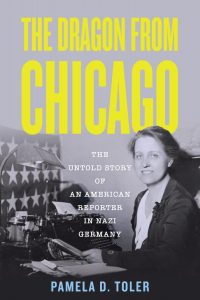One Final Woman War Correspondent: Helen Kirkpatrick
American reporter Helen Kirkpatrick (1909-1997) had already spend five years as a foreign correspondent in Europe when America entered World War II.
She had stumbled into reporting in1 935. After a summer job escorting 30 teenage girls around Europe, she cabled her husband that she wasn’t coming back and found a job with the Foreign Policy Association in Geneva. The FPA was located near the press room in the League of Nation’s building. She not only made friends with reporters, she began covering for them when needed. After a time, the European office of the New York Herald Tribune offer her a job as a stringer with a regular, though very small, salary. She jumped at it.
In 1937, she moved to London, where she worked as a freelance contributor for a number of newspapers. During the Munich Crisis, she was a temporary diplomatic correspondent for the Sunday Times.
During her time in London, she published a weekly newsletter, along with Victor Gordon-Lennox of the Daily Telegraph and Graham Hutton of the Economist. Titled Whitehall News, it campaigned against the British government’s policy of appeasing dictators: Winston Churchill, Anthony Eden, and the King of Sweden were all subscribers. (I assume Neville “Peace in our time” Chamberlain was not.)
Shortly before the war she joined the London office of the Chicago Daily News, the owner of which had previously refused to hire women staff writers. Her first assignment was to get an interview with the Duke of Windsor, who was well known not to give interviews.* Despite the scoffing of her male colleagues, she was able to get a meeting with the former king. He reiterated that he did not give interviews, but saw no reason that he couldn’t interview her. That reverse interview was her first by-lined story in the paper
Kirkpatrick worked for the Chicago Daily News throughout the war. She wrote about the London Blitz, covered the arrival of the first troops of the American Expeditionary Force in Ireland, and spent six months reporting on the North African campaign in 1943, including the surrender of the Italian fleet at Malta. After D-Day, she became the first correspondent assigned to the Free French headquarters in Europe. She entered Paris on August 25 1944 riding in a tank with General Leclerc’s 2nd armored division. Her final wartime assignment was a trip to Hitler’s mountain retreat at Berchtesgaden—almost a required stop for American correspondents at the end of the war.
She was the only woman correspondent who received medals of valor from both the United States and the French governments for her war coverage.
She continued to work as a foreign correspondent for a few years after the war—working for the New York Post, which had taken over the Chicago Daily News. She then moved into the public sector, first as an information officer for the Marshall Plan office in Paris and then as the Public Affairs Office for the Western European Division of the State Department.
She gave up her career when she married Robbins Milbank in 1954. Not an unusual decision at the time, though a loss to journalism.
*This sounds to me like someone was setting her up to fail.
***
One short week until The Dragon From Chicago hits bookstore shelves. Am I excited? Darn tootin’ I’m excited!
Heads up to my Chicago people: The event on August 6 at City Lit Books has been cancelled.






